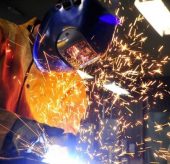 While it is not possible to determine the exact breakdown regarding techniques used in the majority of welding jobs, the general consensus is between 50% and 70% of plastic welding is completed using the ultrasonic method. This was originally developed during the 1960s and has since become the recognized process for joining plastic parts. For more specific information and alternative options; welding supply companies, like Miller Electric, can provide sound advice. For the most part, however, in the absence of a reason to do otherwise, ultrasonic is the preferred method!
While it is not possible to determine the exact breakdown regarding techniques used in the majority of welding jobs, the general consensus is between 50% and 70% of plastic welding is completed using the ultrasonic method. This was originally developed during the 1960s and has since become the recognized process for joining plastic parts. For more specific information and alternative options; welding supply companies, like Miller Electric, can provide sound advice. For the most part, however, in the absence of a reason to do otherwise, ultrasonic is the preferred method!
Laser welding is relatively new and can be an expensive process, with limitations regarding the number of materials that can be applied. However, it provides welds that offer the best precision available, without the flash factor or particulate matter. It is a technique offered by Lincoln Welding Supplies, and can be utilized on a wide variety of joint configurations.
The ultrasonic process creates a weld involving the use of a titanium or aluminum horn, which can be found at Lincoln Welding Supplies. The horn vibrates vertically and melts material at the join, thereby clamping two pieces together—heat is generated through the process by molecular vibration and friction.
The determined vibration frequencies extend from 15,000 to 72,000 hertz, but most applications use about 20,000 hertz or in the range of 30,000–40,000-hertz. In certain instances, those involving small consumer products, between three and four welding operations can be performed with a single composite horn. The composition is a drive horn with multiple extenders.




